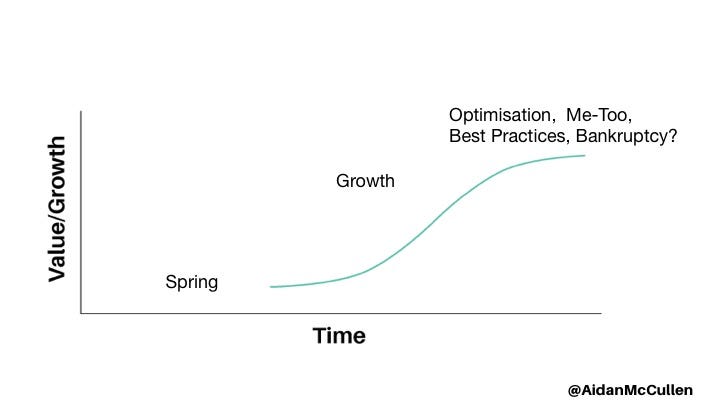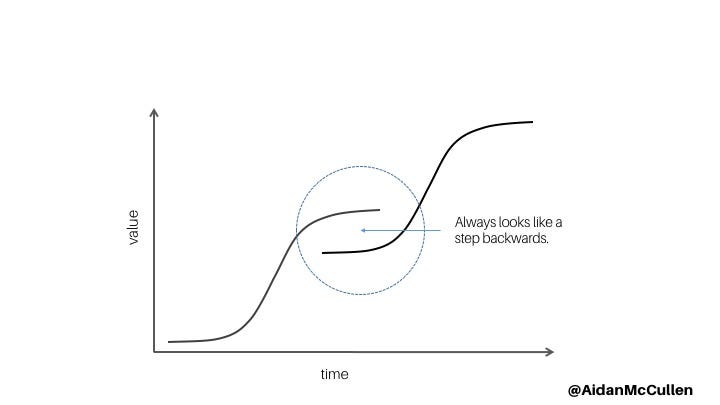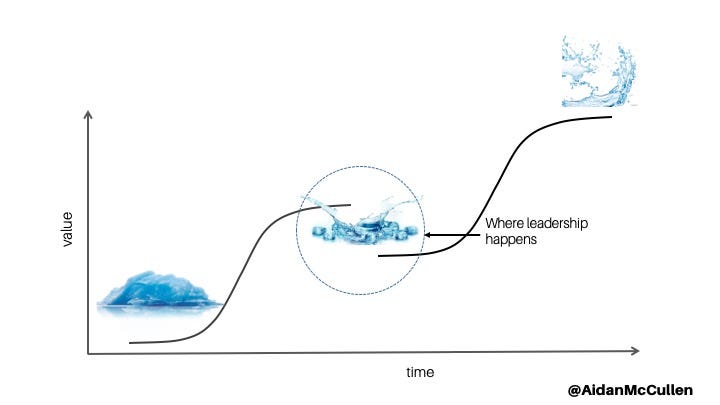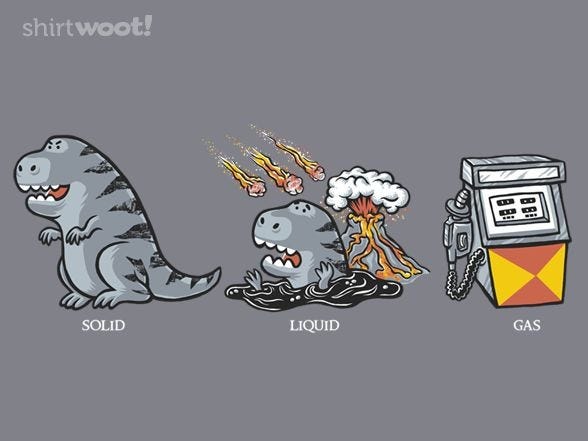
“You must be shapeless, formless, like water. When you pour water in a cup, it becomes the cup. When you pour water in a bottle, it becomes the bottle. When you pour water in a teapot, it becomes the teapot. Water can drip and it can crash. Become like water my friend.” — Bruce Lee
A phase transition is when a substance changes from a solid, liquid, or gas state to a different state. Every element and substance can transition from one phase to another at a specific combination of temperature and pressure.
It is the same substance but behaves radically differently under varying circumstances.
For example:
- Melting: The transition from the solid to the liquid phase
- Freezing: The transition from the liquid phase to the solid phase
- Evaporating: The transition from the liquid phase to the gas phase
- Condensing: The transition from the gas phase to the liquid phase
- Sublimination: The transition from the solid phase to the gas phase
- Deposition: The transition from the gas phase to the solid phase
Each substance has three phases it can change into; solid, liquid, or gas.
Every substance is in one of these three phases at certain temperatures.
For the purpose of this Thursday Thought, I want to highlight that a substance can coexist in two phases at the same time when the substance is transitioning from one phase to another, called a two-phase state. Taking the example of ice melting, water coexists as both solid water and liquid water simultaneously.
Phase transitioning is a fantastic analogy, which our guest on the Innovation Show, Safi Bahcall uses to explain how business leaders must manage controlled disruption/cannibalisation/innovation within their business or industry. When a business is mature it exists in a more solid, crystallised state, but must equally exist in a liquid, fluid, agile state.
Transition Curves

For regular followers of The Thursday Thought, you will be familiar with the concept of the S curve. S curves are a great way to both describe and map the performance of a company or a product over a period of time. S curves follow the shape of the letter S with a flat growth at the bottom of the S, rapid growth comes next, followed by a dominant position in the market at the top of the S.

When a business or product is established, they eventually start to plateau and experience stagnation, process optimisation, automation, job cuts and me-too propositions.
To Innovate Companies and Leaders need to manipulate a situation of jumping from one S curve to another, from one phase to the next. This jump always looks like a step backwards and therein lies a major challenge.

When business realise they need to jump to a new curve it is often too late. The initial business must not become “too crystallised” to accept a new “liquid state”

To adopt an innovation mindset, even if we lead an established business, leaders must manage the tension of phase transitions, of the jump from one phase/curve to the next. We must manage the business as it is today and the business as it “MAY be” tomorrow. The jump is a punt and it may be based upon best-guess assumptions, so several jumps may be necessary in order to land upon the correct next phase. In order to succeed, we must be willing to accept failure.
Catalysts of Phase Transitions
“Leadership is doing the right things; management is doing things right.” –Peter Drucker.
The Druker quote above is often used to make a distinction between managing processes and leading people. While this is true, a leader is also the person who leads the future of the business, who identifies a new direction or several new directions. A leader is the person who leads the crystalised phase and who leads the liquid, embryonic phase. In business, many leaders are so busy managing the business that they do not have time to lead the business. To add complexity, the support of a leader by shareholders and boards of directors is often limited to managing the crystalised phase, the business as it is today, even when that business stagnates and when entropy reigns supreme.

Phase transitions are often catalysed when a business is faced with a burning platform such as a change in regulation (like banks facing PSD2), the rise of a competitor (startups threatening incumbents) or the demise of profits.
Such catalysts are akin to heat turning liquid to gas or cold turning water into ice. The true leader is proactive in such catalysts, they do not wait for a surprise catalyst, they become the orchestrator of catalysts.
Bilingual Leaders

While recognising phase transitions, orchestrating them and indeed rallying support for them is paramount, there is an important skill that is required for a leader to succeed. Leaders must speak the language of each phase. They must communicate to those who lead the liquid state and translate their objectives effectively to those who lead the crystalised state and vice versa. In addition, leaders must “love” all phase workers equally.
Imagine you are working in the innovation lab of an established well-oiled business. You have never seen the CEO of that business. In addition, you rarely see the leader of your innovation team, they are usually embroiled in the politics of the business. You would be forgiven for thinking that it is a case of “us against them”, “liquid against ice”, “the old against the new”. To make matters worse, your small wins are rarely celebrated, while every win is celebrated for the established business. This becomes tedious, disenchanting and disheartening. Your commitment starts to wane and you find a job elsewhere where your achievements are appreciated. In some cases, this means giving up on the dream of creating something new, something disruptive, instead, you find solace in incremental innovation, in minuscule improvements. This is not entirely satisfying, but you resign yourself to your new reality.
The alternative is for a leader to manage all parties equally. As our guest on the Innovation Show, Safi Bahcall (who inspired this article with his book Loonshots) tells us failure to love soldiers and artists equally will lead to failure. Steve Jobs learned this the hard way when he called the workers managing the established Apple “bozos” or “the navy” and he referred to the team managing what he deemed important projects “pirates”. Jobs proudly proclaimed that “I’d rather be a Pirate than in the Navy”. Despite his intentions to inspire the pirates/artists, his impact was to alienate the navy/soldiers/bozos. This leads to distrust, toxicity and failure. Years later, when Jobs returned to Apple, he learned to love both equally and he discovered his role was to be the synthesiser of an ecosystem, the orchestrator of phase transitions.
In summary, for successful innovation to happen, leaders must identify and support phase transitions. Leaders must identify catalysts. Leaders must manage all phases and ensure the workers within those phases feel equal love and support. All phases need each other. Without the certainties of the established business, the high failure rates of emergent business could bankrupt companies and industries. Without fresh ideas from the emergent phases, the established will eventually “phase out” and die, everything has a decay rate.
On this week’s Innovation Show we talk to scientist, entrepreneur and author of Loonshots: How to Nurture the Crazy Ideas That Win Wars, Cure Diseases, and Transform Industries Safi Bahcall.
Safi reveals a surprising new way of thinking about the mysteries of group behaviour that challenges everything we thought we knew about nurturing radical breakthroughs.
We talk:
- What are #Loonshots ?
- How structure is as important as culture
- Phase transitions
- How Innovation saves Empires
- Why Innovation gets rejected
- The rejection of radar before the War
- The rejection of lifesaving drugs
- The three deaths (fails)
- Listening to the Suck with Curiosity
- Understanding Failure
- Avoiding the Moses Trap
- Loving Soldiers and Artists
- Managing the tension of the emergent and the established
- How Steve Jobs learned to love Artists and Soldiers
- The genius of Richard Miller, Judah Folkman, Vannevar Bush, Theodore Vail, Sir James Black, Akira Endo, Deak Parsons, Leo Young, Lawrence Hyland and Steve Jobs.
Have a Listen: Web http://bit.ly/2FwsOJw
Soundcloud https://lnkd.in/gBbTTuF
Spotify http://spoti.fi/2rXnAF4
iTunes https://apple.co/2gFvFbO
Tunein http://bit.ly/2rRwDad
iHeart http://bit.ly/2E4fhfl
More about Safi here:
